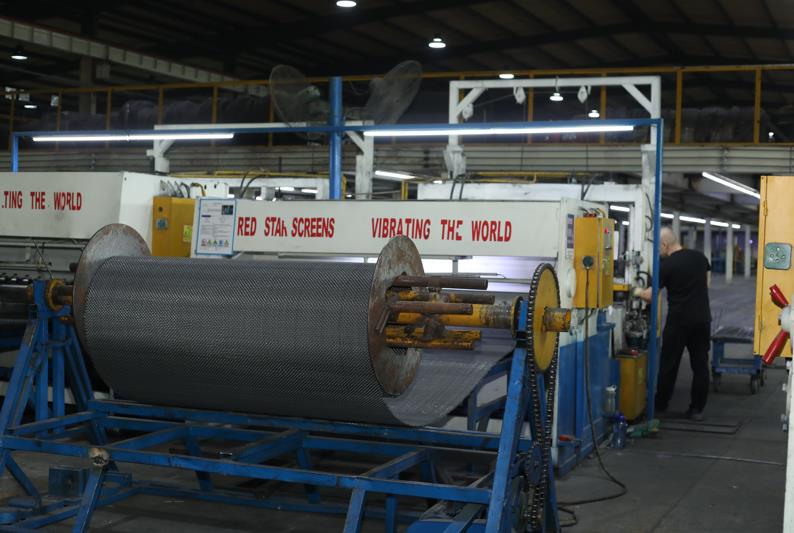Detailed explanation of the application of metal screen in material screening
As the most widely used screen at present, metal screen plays a very important role in mine screening Whether it is a coarse screen, a fine screen or a powder screen, you can see the figure of metal screen
As the most widely used screen at present, metal screen plays a very important role in mine screening. Whether it is a coarse screen, a fine screen or a powder screen, you can see the figure of metal screen.
The mesh of the metal wire screen is larger and has higher strength. It is often used to screen coarse materials. For example, the coarse screen and the graded screen in the flat screen often use metal wire screen. The main parameters of the commonly used metal wire screen are generally expressed by W to indicate the specifications of the metal wire screen. For example, 22W means that there are 22 mesh holes per inch (1 inch = 2.54 mm) on the screen surface, using steel wire with a diameter of 0.305 mm, a hole width of 0.85 mm, and an effective screening area of 54.3%. This kind of screen is often used as the coarse screen surface of the front road leather grinding flat screen. The larger the mesh size, the coarser the steel wire used, and the larger the effective screening area.

The fully twisted woven screen is suitable for screening medium-sized materials, such as the screen surface of graded screens and fine screens in flat screens. Due to the full twisted weave, the screen hole is not easy to deform, but it is thick and not suitable for screening fine materials. The screen woven with nylon silk has the advantages of uniform aperture, flat surface, wear resistance and anti-static, and is currently the most commonly used screen material. It is often used as the screen surface of the graded screen of the flat screen. The powder purifier in the powder circuit often uses JMG type screens, and the fully twisted woven screen woven with nylon silk can also be used.
The screen mesh used for the powder screen has a small mesh, and is often made of nylon silk, silk and stainless steel wire to screen finer materials. Among the screen surfaces of the flat screen, the powder screen mesh is more easily worn. During the production process, the changes in the number of bran stars in the powder should be checked frequently. If it is not due to raw materials, operation and other reasons, the increase in bran stars in the powder indicates that the screen has been damaged, and it should be checked and replaced in time during the daily maintenance of the equipment. Due to changes in raw materials, climate, product quality, operating requirements, etc., it is often necessary to adjust the grading screen surface and the powder screen surface.
Actual use shows that the life of the fine mesh screen (mesh size is 10-12-16 mm) composed of grooved copper wire does not exceed 200-300 hours of continuous work. In order to improve the durability of the screen, a method of coating the screen wire with rubber has been adopted in foreign factories recently, that is, the screen wire is coated with a layer of wear-resistant rubber. In some factories, the screen coated with rubber has not been found to be worn even after 6000 hours of continuous work. However, it should also be considered that the effective area of the rubber-coated wire screen must be reduced.
Another disadvantage of the fine screen is that it can be quickly blocked by wet and sticky materials; to overcome this disadvantage, the following methods are proposed.
The simplest way to prevent the screen from being blocked is to use a manufactured black wire screen. In this case, the so-called "silk screen" on the edge of the sleeve of the factory is preferred. In this case, the screen surface made of metal wire is only composed of some longitudinal metal wires.
Therefore, the working surface of the string type screen is similar to the screen grid or screen bar in appearance, except that it uses copper wire instead of the grid bar or bar. A metal wire segment equal to twice the length of the screen is wound back and forth along the screen from the lower end of the screen body. The free end of the metal wire segment is fastened to the crossbeam at the lower end of the screen body, and the circle formed by the other end is fixed to the hook at the upper end of the screen body.
When selecting the gap size between the string wires, in order to make the particle size of the screened product the same, the gap must be smaller than the square hole size of the equivalent screen. In order to obtain the same particle size of the screened product, it is recommended to use a string wire screen with a gap width of 0.7-0.8 times the square screen hole width.
The operating experience of the string wire screen shows that the wear resistance of this screen surface is several times higher than that of the ordinary screen. This is because the string wire screen only needs to repair the damaged part, and only the broken or worn string wire is replaced, and most of the screen surface can continue to be used in the future.



